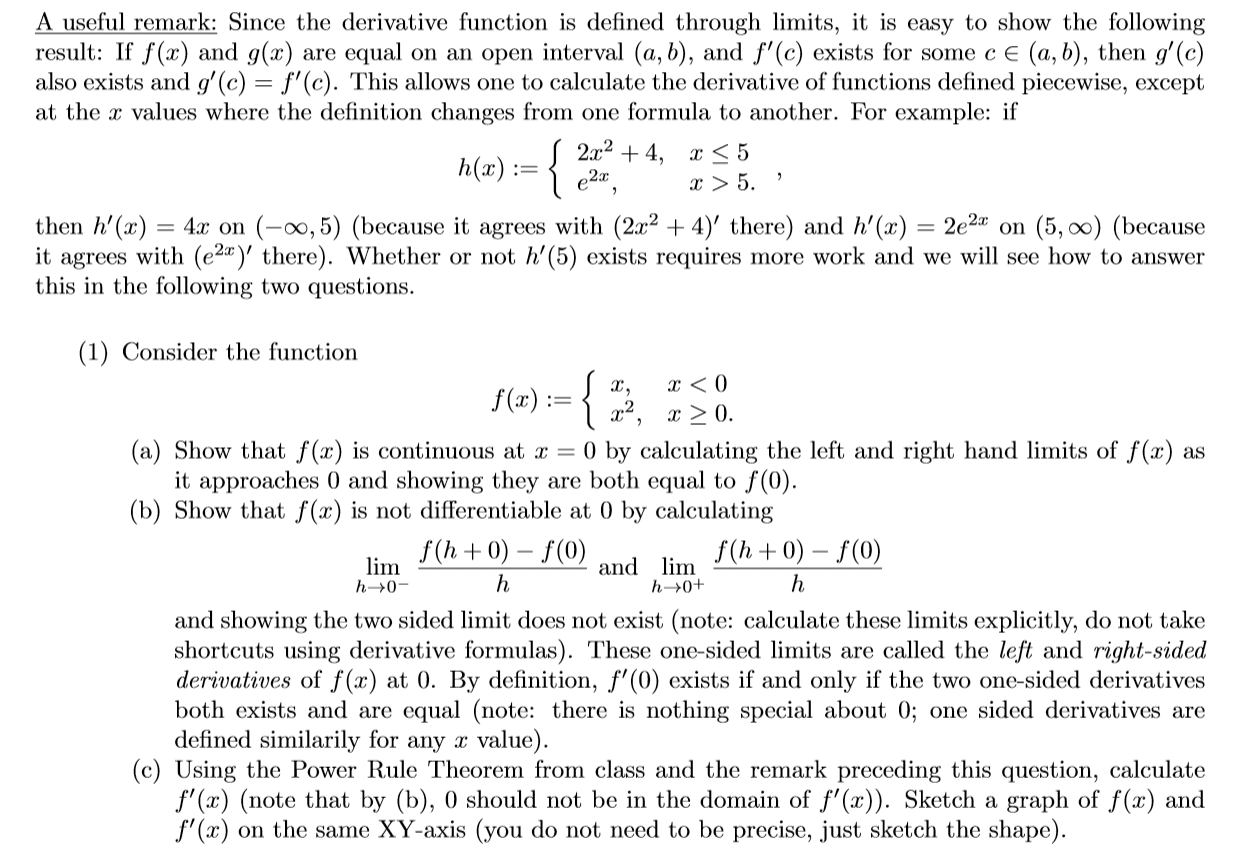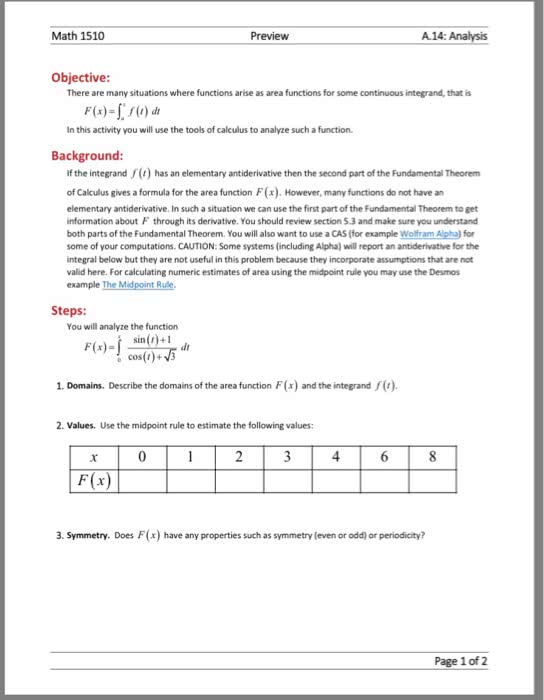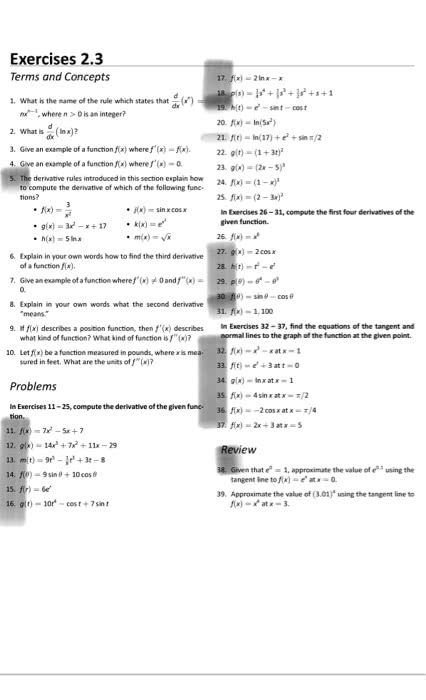MATH 1041 Chapter Notes - Chapter 3: Quotient Rule, Trigonometric Functions, Product Rule
Document Summary
The power rule if (cid:1866) is a positive integer, then (cid:1856)(cid:1856)(cid:1876)(cid:4666)(cid:1876)(cid:4667)=(cid:1866)(cid:1876) (cid:2869) The constant multiple rule if (cid:1855) is a constant and (cid:1858) is a differentiable function, then (cid:1856)(cid:1856)(cid:1876)[(cid:1855)(cid:1858)(cid:4666)(cid:1876)(cid:4667)]=(cid:1855)(cid:1856)(cid:1856)(cid:1876)(cid:1858)(cid:4666)(cid:1876)(cid:4667) The sum rule if (cid:1858) and (cid:1859) are both differential, then (cid:1856)(cid:1856)(cid:1876)[(cid:1858)(cid:4666)(cid:1876)(cid:4667)+(cid:1859)(cid:4666)(cid:1876)(cid:4667)]=(cid:1856)(cid:1856)(cid:1876)(cid:1858)(cid:4666)(cid:1876)(cid:4667)+(cid:1856)(cid:1856)(cid:1876)(cid:1859)(cid:4666)(cid:1876)(cid:4667) The difference rule if (cid:1858) and (cid:1859) are both differentiable, then (cid:1856)(cid:1856)(cid:1876)[(cid:1858)(cid:4666)(cid:1876)(cid:4667) (cid:1859)(cid:4666)(cid:1876)(cid:4667)]=(cid:1856)(cid:1856)(cid:1876)(cid:1858)(cid:4666)(cid:1876)(cid:4667) (cid:1856)(cid:1856)(cid:1876)(cid:1859)(cid:4666)(cid:1876)(cid:4667) (cid:1856)(cid:1856)(cid:1876)(cid:4666)(cid:1857)(cid:3051)(cid:4667)=(cid:1857)(cid:3051) The product rule if (cid:1858)and (cid:1859) are both differentiable, then (cid:1856)(cid:1856)(cid:1876)[(cid:1858)(cid:4666)(cid:1876)(cid:4667)(cid:1859)(cid:4666)(cid:1876)(cid:4667)]=(cid:1858)(cid:4666)(cid:1876)(cid:4667)(cid:1856)(cid:1856)(cid:1876)(cid:1859)(cid:4666)(cid:1876)(cid:4667)+(cid:1859)(cid:4666)(cid:1876)(cid:4667)(cid:1856)(cid:1856)(cid:1876)(cid:1858)(cid:4666)(cid:1876)(cid:4667) The quotient rule if (cid:1859) and (cid:1858) are differentiable, then (cid:1856)(cid:1856)(cid:1876)[(cid:1858)(cid:4666)(cid:1876)(cid:4667)(cid:1859)(cid:4666)(cid:1876)(cid:4667)]=(cid:1859)(cid:4666)(cid:1876)(cid:4667)(cid:1856)(cid:1856)(cid:1876)[(cid:1858)(cid:4666)(cid:1876)(cid:4667)] (cid:1858)(cid:4666)(cid:1876)(cid:4667)(cid:1856)(cid:1856)(cid:1876)[(cid:1859)(cid:4666)(cid:1876)(cid:4667)] Example 2 let (cid:1877)=(cid:3051)(cid:3118)+(cid:3051) (cid:2870) (cid:3051)(cid:3119)+(cid:2874) then (cid:1877) =(cid:4666)(cid:1876)(cid:2871)+(cid:888)(cid:4667)(cid:1856)(cid:1856)(cid:1876)(cid:4666)(cid:1876)(cid:2870)+(cid:1876) (cid:884)(cid:4667) (cid:4666)(cid:1876)(cid:2870)+(cid:1876) (cid:884)(cid:4667)(cid:1856)(cid:1856)(cid:1876)(cid:4666)(cid:1876)(cid:2871)+(cid:888)(cid:4667) (cid:4666)(cid:1876)(cid:2871)+(cid:888)(cid:4667)(cid:2870) Here the inner function is (cid:1859)(cid:4666)(cid:1876)(cid:4667)=(cid:1871)(cid:1866)(cid:1876) and the outer functions is the exponential function (cid:1858)(cid:4666)(cid:1876)(cid:4667)=(cid:1857)(cid:3051). 3. 5 implicit differentiation the method of implicit differentiation consists of differentiating both sides of the equation with. Remembering that (cid:1877) is a function of (cid:1876) and using the chain rule, we have respect to x and then solving the resulting equation for (cid:1877) .




